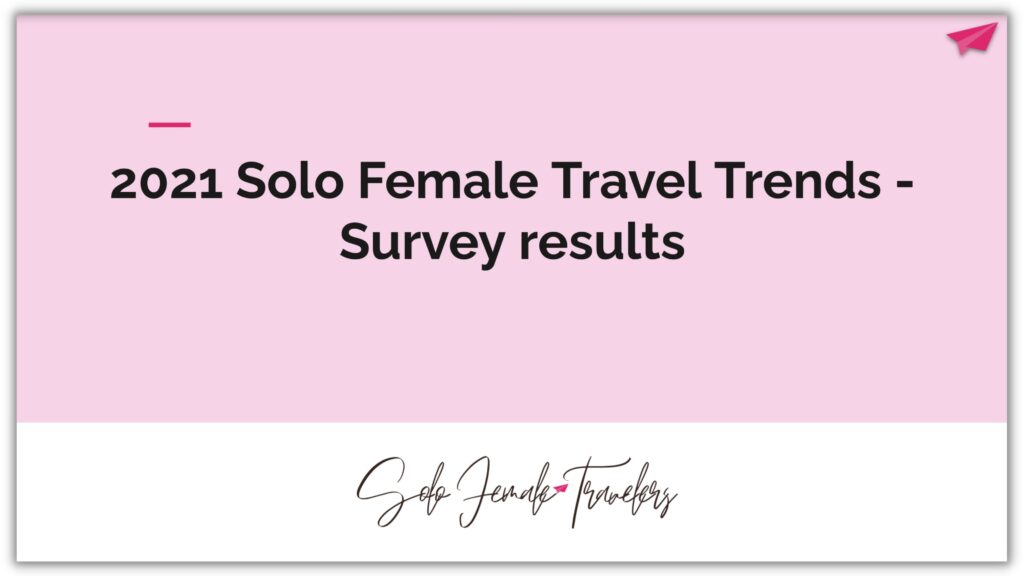Every year, 5,000 women take part in the annual Solo Female Travel Trends Survey, the largest, most comprehensive and only global research study on solo female travel trends, preferences and behaviors. On this page, you will find the most updated results from 2022.
Why solo female travelers should matter to your travel business
A 2019 non-gender specific study found that 76% of travelers had gone on a solo trip or were considering going. Among women, the interest is is growing exponentially.
Searches for the term “solo female travel” increased 6 fold during the 4 years preceding the beginning of the COVID 19 pandemic and we expect it to recover to 2019 levels by the end of 2022.
Women make the overwhelming majority of travel bookings, for themselves, for their families, for their parents, for their colleagues and for their friends, and represent 70% of the hotel website visits. They are the real travel influencers.
Building trust with women offers opportunities to connect at a deeper level with the decision maker in travel beyond the solo trip.
A positive experience with a brand as a solo female traveler will open the doors to future bookings as a family, couple, group of friends or even for a business trip.
Women also occupy the majority of jobs in the travel industry, yet they make up only a small percentage of the executive positions.
Male decision-makers in tourism cannot understand or relate to the challenges women traveling solo face resulting in the segment being neglected and underserved.
In communication campaigns, the travel narrative is mostly focused on couples and families and does not speak to the solo traveler, let alone the solo female traveler.
“Employ more women in executive roles at travel companies so they actually know what it’s like to travel as a woman. Without a seat at the table, decisions are made about us, not with us.”
The above numbers and factors are in stark contrast with the understanding of the challenges, worries and experiences of women traveling solo, and with companies and destinations lack of focus on catering to this large and growing segment.
This presents an enormous opportunity for savvy players to get to know us better and to offer products that understand our challenges. Brands and destinations that do so will take the lead and position themselves as the winners, at least in the short term.
Also on this page: Purchase the detailed reports I Learn how you can better serve solo female travelers
Summary of Solo Female Travel Statistics
In the following sections you will find detailed solo female travel statistics and results from our survey. Before we dive deep, below are the key findings from the 2022 survey:
1. Travel companions: 80% of solo travelers also travel with others; solo travel isn’t a lifestyle but a travel style suitable for some trips.
2. Interest in group travel: 65% are interested in women-only group travel, 66% more than in 2020.
3. Why do you travel solo: Freedom and flexibility (90%), Get away from routine and responsibilities (86%, not among top reasons in 2020), Challenge themselves (84%), Relax, self-care and enjoy me-time (83%) are top reasons for solo travel. Lack of travel partners is not a main reason. 85% of Gen Z travel to meet people.
4. Solo female travel worries: Changing travel restrictions worries solo female travelers more than personal safety (74% vs. 64%). Safety worries decreases from 75% to 52% for those with more than 10 solo trips.
5. What stops you from traveling solo: Those who have never traveled on their own worry about safety (65%) and about higher costs (64%). 20% didn’t know solo travel was an option for them. 68% would be more likely to book a solo trip if joining a women-only tour.
6. Best destination for a first solo trip: is a domestic destination within the travelers’ home country. The most recommended continent is Europe and the top-5 countries are Italy, UK, Spain, Thailand, and Australia. Same top-5 as in 2020 with slight changes in the order.
7. Whose recommendations do you trust: Women traveling solo trust the advice from solo female travel Facebook groups (76%), more than they trust their friends and family’s (73%) and blogs (67%). 29% distrust influencers, more than the travel brands who hire them (17%). The figures on content creators are more polarising than in 2020.
8. Bucket list destinations: Italy takes the top spot across nationalities except for Europeans, followed by Greece, Australia, Iceland and Japan. This list is unchanged from 2020 except for New Zealand and Canada which dropped from the list.
9. How do you choose a destination: Cultural experiences (82%), safety (69%), the beauty of a place (69%), nature (58%) and the country’s reputation (58%) are top decision factors. Having opportunities for Instagram shots, spending time at the spa or shopping are not important. Affordability of a destination is a decision factor for 60% of respondents and single supplements are mentioned as a major barrier to solo travel.
10. Activities: Women look for cultural sightseeing and immersion as well as nature / wildlife when traveling solo. Adventure activities, the beach and culinary activities are important to more than 50% of respondents.
11. Price drives 56% of women when choosing a travel provider. Beyond price, 46% of women traveling solo think that a travel provider’s eco-friendliness and care for the environment is important or very important, 37% care about whether a business is locally owned, and 31% value its social responsibility. 18% of women value female-owned businesses.
Detailed Solo Female Travel Survey Results – Analysis and Statistics
In these sections, you will find detailed solo female travel analysis, graphs and insights.
1. Traveling solo is a choice not necessarily a lifestyle
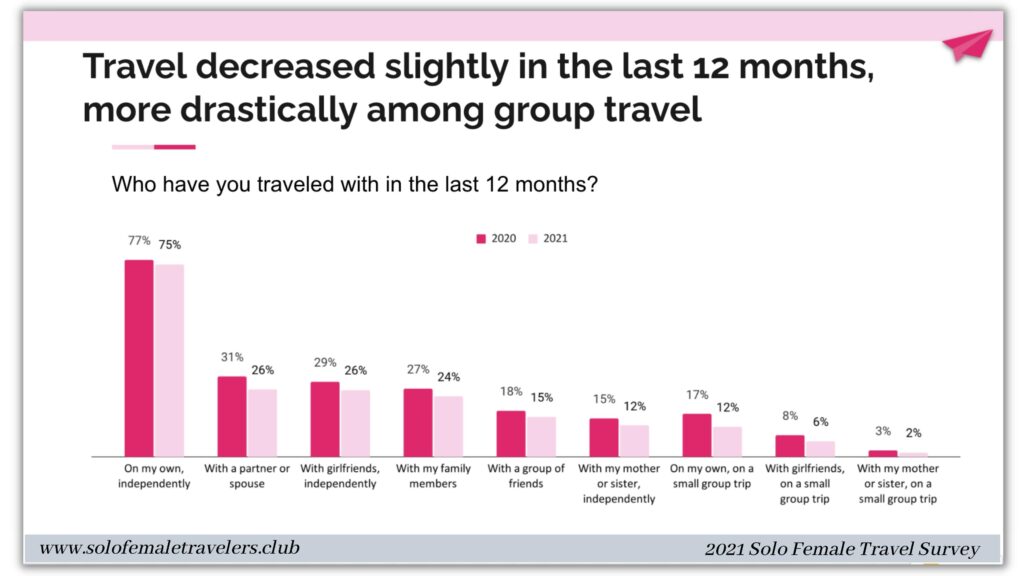
For the majority of women, solo travel is just another travel style, and does not stop them from also traveling with others; they may go on one trip by themselves, and then on a different trip with their partner or family.
“Make it known that it’s a normal every day thing that women do.”
Findings / Key Insights
- Only 20% of respondents indicated they only traveled solo in the last 12 months.
- The majority of solo female travelers combine various travel styles and companions depending on the destination and type of trip. Women traveling solo may go on a road trip with friends, a romanic getaway with a partner or on a self-care trip on their own.
- A quarter of solo female travelers have also been on trips with their partner, their girlfriends and their family in the previous 12 months.
- 12% joined a small group trip in the last 12 months, 30% less than in 2020 most likely as a result to the halt in group trips because of the pandemic.
2. Interest in group travel has more than doubled vs 2020
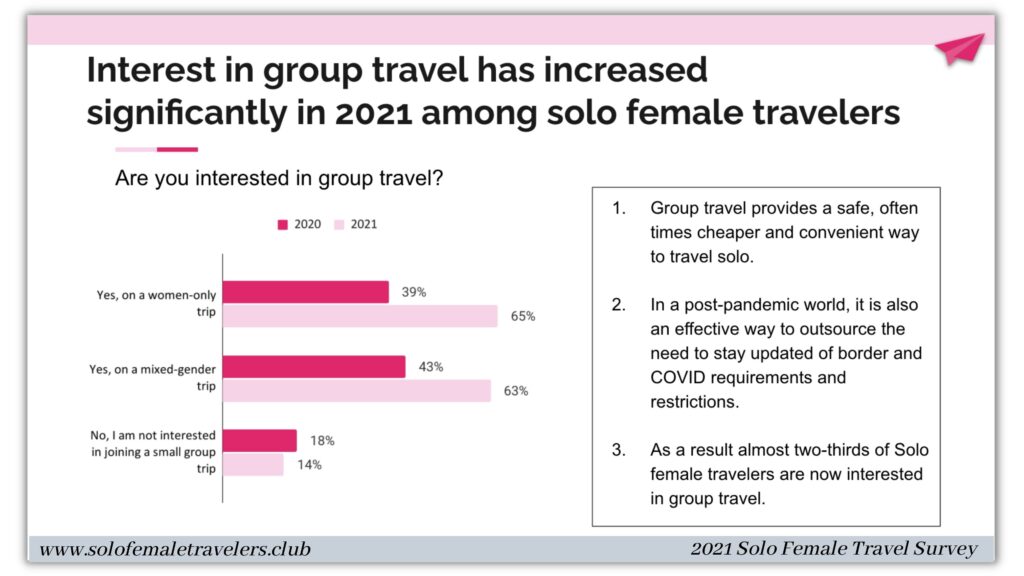
Interest in group travel has increased by over 60% in 2021 when compared to 2020, most likely as a result of the pandemic making it more complex to navigate border restrictions and travel requirements.
Findings / Key Insights
- Interest in group trips has increased 66% for women-only tours and 46% for mixed gender group trips. Only 14% of respondents are not interested in group trips.
- The pandemic has made independent travel much more complicated and requiring the need to stay up to date with border controls and COVID restrictions. Travel professionals and group tour companies help navigate this reality by providing up to date, first hand information.
3. No partner, no problem
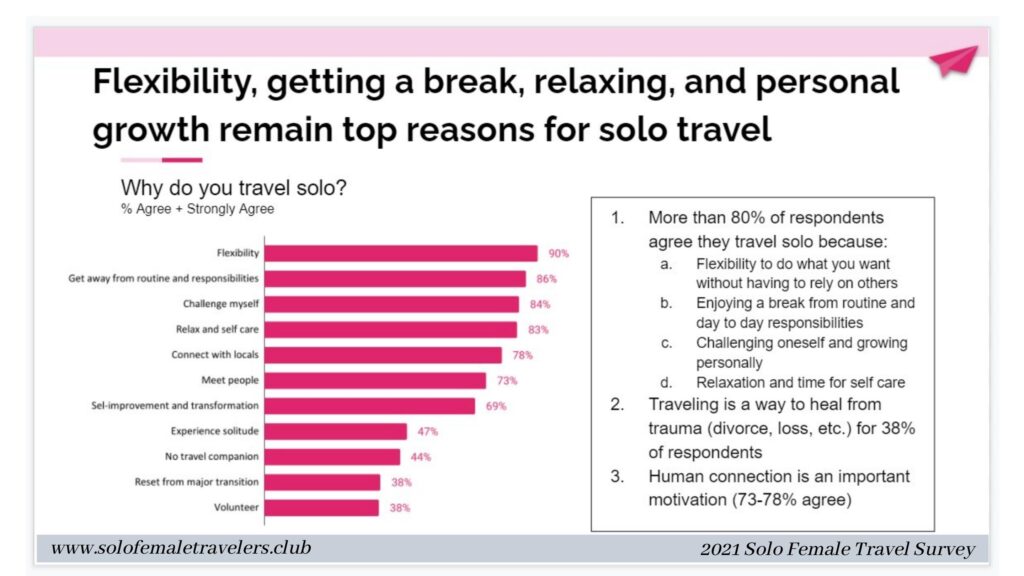
Women travel solo for a variety of reasons, the lack of a travel companion is just one of many.
Findings / Key Insights
- 90% of respondents agree that they travel solo because of the flexibility it affords. This is true regardless of the respondent relationship status. Millennial and Gen Z agree more than the rest with this.
- 86% of respondents travel solo to get away from routine and day to day responsibilities. This is particularly true of Millennials and Gen X.
- 84% of respondents seek to challenge themselves, a key benefit of solo travel. For Gen Z, this is the number one reason to travel solo with 97% agreeing, versus only 73% of Boomers.
- 83% travel on their own to relax. Travel is one of the best ways to spend a vacation, re-energize and recharge, and solo travel gives that extra layer of quietness that does not depend on others.
- 78% travel to connect with locals. There are differences by age. Boomers are more keen to connect with locals (83%) than Gen X (76%).
- 85% of Gen Z travel to meet people vs. the average of 73%.
“People think that you are on a solo trip because you don’t have anyone to go with you, but most of the time you do it because you don’t care if someone else wants to go with you.”
- No partner, no problem! Women are not letting the lack of company stop them from traveling. 44% said they travel solo because their partner is not interested in the trip or because they cannot find a travel companion with a similar vacation schedule.
- 38% travel solo to heal from a major life transition. A change of scenery or getting away from the environment that may remind us of a traumatic experience is one of the many ways to cope with it. This is especially true for Millennials (44%).
4. Changing border restrictions worries solo female travelers more than safety
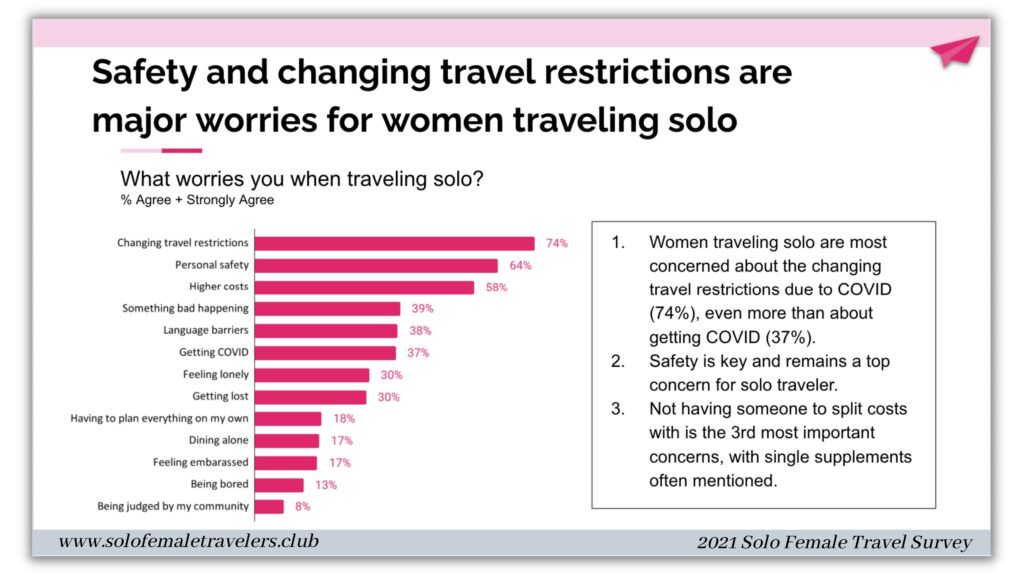
Women are very worried about their safety when traveling solo. Experience traveling solo reduces this fear, however it still remains alarmingly high at 52% for those who have traveled solo more than 10 times.
Concerns over safety are unique to the female experience regardless of how experienced a solo traveler is. Respondents specifically worry about the lack of credible sources on real safety data per destination and the travel industry’s marketing efforts to make a destination look safer than it actually is.
However, changing border restrictions is now the most important concern for women traveling solo. Border closures, last minute changes in costs or travel arrangements, being forced to change or cancel a trip, getting stuck abroad or the stress of last minute test requirements are top of mind.
Findings / Key Insights
- 74% of respondents worry about changing travel restrictions. The impact of the pandemic is top of mind for travelers in general but more so for solo travelers who may be stuck and alone in a foreign country.
- Solo female travelers are concerned about the impact their return being delayed may have on family and work commitment left behind.
- 64% of solo female travelers worry about their safety. Experience traveling solo reduces this fear from 75% among women who have traveled solo less than 5 times to 52% for those who have traveled more than 10 times on their own.
- Beyond safety, solo female travelers most worry about the higher costs of traveling solo due to single supplements charged (47%), of getting lost (27%) or of feeling lonely (25%).
“I do worry about not being able to get back home to my young boys. I don’t worry as much about getting sick as about getting stuck and the trip having to be extended”
- Safety is also a barrier for women to go on a solo trip. 65% of women who haven’t traveled on their own yet cite the fear of something happening to them as the reason for not doing it.
- More safety measures remains the number one request from solo female travelers to the travel industry. 34% of the respondents mentioned this in an unprompted question.
- All concerns women have when traveling solo decrease with experience except for the fear of getting COVID.
5. Small group trips can help women go on their first solo trip
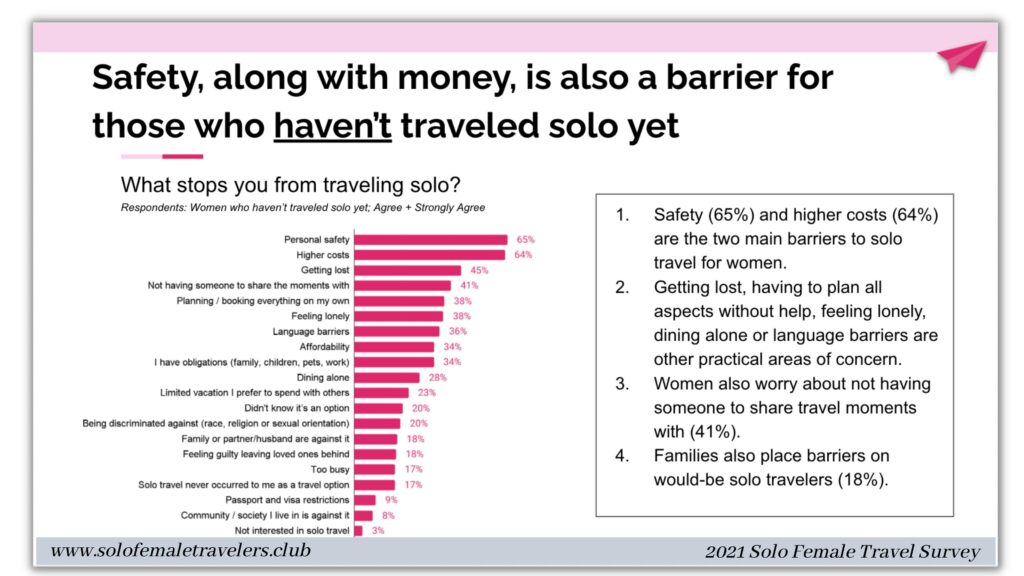
“I actually just wish my family and friends were more supportive. Any resistance I get always comes from someone closer to home.”
Traveling solo as a woman faces a lot of stigma and is subject to the opinions of many. Some do not know this is a possible travel style, others need permission from those around them.
In order to complement our research, we also drew a sample of 1,000 responses from women who have yet to travel solo and we asked them what is stopping them.
Findings / Key Insights
Women who have not traveled solo yet also worry about safety (65%), but there are also a range of other barriers stopping them from booking their first solo trip.
- 64% said they can’t afford the higher price, 45% worry about getting lost, 41% worry about not having anyone to share the special moments of travel with, 38% mentioned the fear of feeling lonely, or of having to book the entire trip on their own.
- Society’s expectations on women also prevent them from traveling solo; 18% said their partner does not approve of them traveling alone, 18% indicated they would feel guilty leaving their family or husband behind and 8% said their community is against it.
- 68% of women who have never traveled solo would be more likely to do so in a women-only small group trip.
- Between 17% and 20% did not know solo travel was an option for them. This is an opportunity for the travel industry to promote a new travel style and expand their addressable market.
6. The ideal first-time solo travel destination is your own country or in Europe
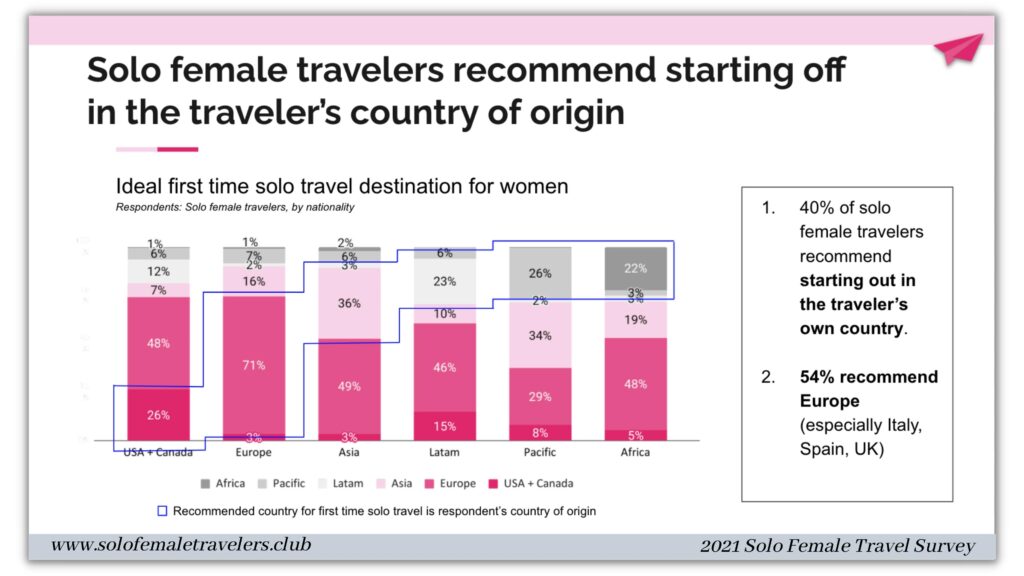
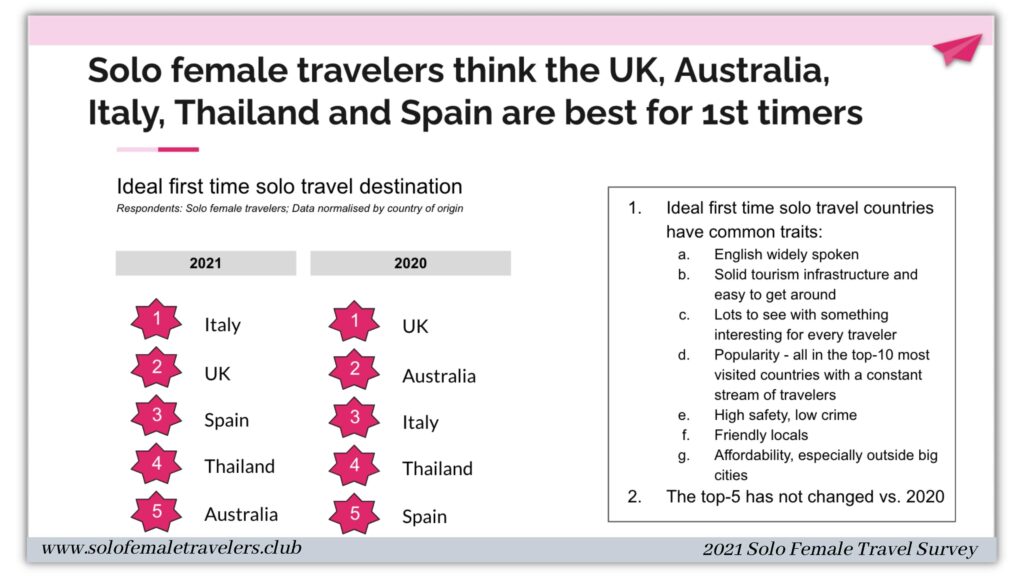
Solo female travelers should start off either in Europe or in their country of origin, where the culture shock is lower (same country, language, similar culture and traditions, etc.).
It is also worth noting that, while there are some universally recommended options for the ideal destination a first time solo traveler should start with, there isn’t a one-size-fits-all choice and each traveler should consider their own personal circumstances when deciding.
Findings / Key Insights
- 40% of solo female travelers recommend their country of origin as the best destination for a first time solo trip.
- 54% of solo female travelers recommend Europe as the ideal first time solo travel destination for women.
- The top countries for solo female travelers are the Italy, UK, Spain, Thailand, and Australia, be it because:
- They are major tourism destinations.
- They enjoy really high levels of safety.
- They have great tourism infrastructure.
- They are affordable.
- They have friendly locals.
- They see a constant stream of solo travelers to beat loneliness and boredom.
- After another year of border closures, Asia-Pacific destinations have disappeared from the top of mind.
- Women who haven’t traveled solo yet consider Italy, Greece, Iceland, Spain and France ideal first solo travel destinations.
7. Friends and Family and SFT online communities are the most trusted sources of advice. Influencers are not trustworthy
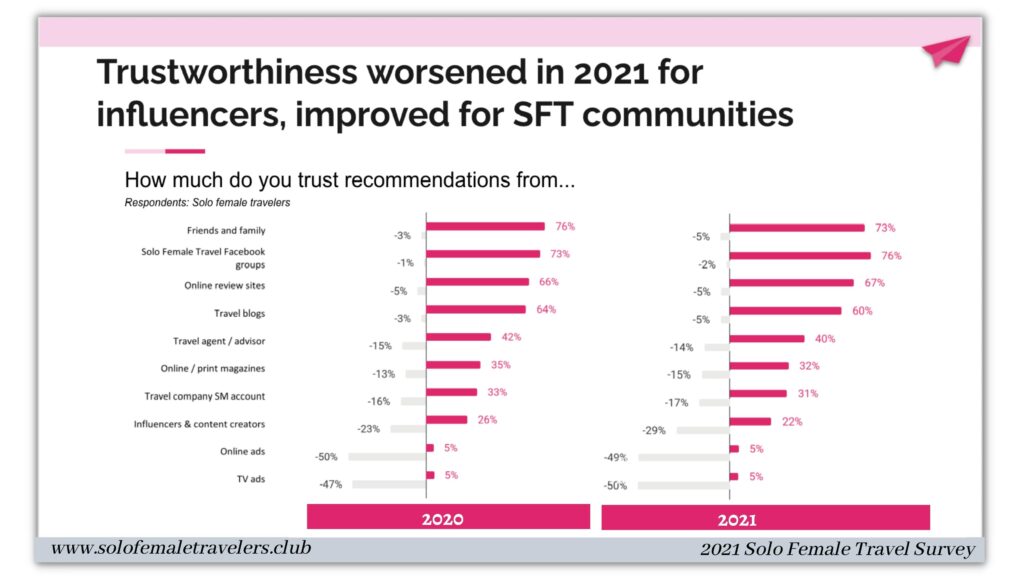
When planning a solo trip as a woman, getting trustworthy and relevant advice is critical and can make or break a trip, especially when it comes to safety tips and recommendations for things to do or places to stay.
Recommendations from Friends and family are most trustworthy across age groups, closely followed by recommendations from other solo female travelers in Facebook groups with likeminded individuals.
Context and relatability matter, and solo female travelers want to hear from other women who travel solo within the safe environment of an online community of like minded individuals.
This reinforces the previous finding that safety is a multi-faceted issue and women traveling solo demand reliable, accurate and actionable safety data from a relevant source and the practical tools to keep themselves safe.
“Have honest and trustworthy reviews and ratings, not ones that are sponsored or can be bought in any way- including influencers that do not say their honest opinion”
Recommendations and advice from Influencers are mostly distrusted, especially by Millennials and Gen Z. They remain a source of information but their trustworthiness is almost as high as their untrustworthiness.
Findings / Key Insights
- Solo female travelers trust relatable (with solo travel experience), reliable (honest) and relevant (like them) sources. Friends and family, solo female travelers, online review sites and blogs are most trusted.
- Influencers are considered less trustworthy than the brands who hire them. Influencers, Instagrammers, YouTubers and other content creators have very low trust levels with less than one quarter of respondents considering them trustworthy or very trustworthy sources. This is a lower level of trust than enjoyed by travel brands’ social media networks (31%).
- Levels of trust towards Influencers, Instagrammers, YouTubers and other content creators have decreased vs. 2020. 29% find them not trustworthy or very untrustworthy vs. 23% in 2020.
- Online and TV ads are not trusted by solo female travelers with over 40% of respondents considering them as untrustworthy sources.
- Millennials and Gen Z trust online channels, particularly Facebook groups (who they trust more than F&F 88% vs. 79%), online review sites and blogs. However, they are weary of travel agents and only 34% trust them, 19% distrust them.
- Boomers are skeptical of online marketing channels but over 50% trust travel agents.
8. Solo Female Travelers dream of places far away and exotic

Women traveling on their own dream of places that are far away but there is a degree of overlap between bucket list destinations and recommendations for first time travelers (eg. Italy, Australia).
Greece appeared on the bucket list in 2020 as a result of opening earlier than any other country in Europe after the COVID lockdowns, and remains on it in 2021.
Findings / Key Insights
- Top countries on Solo Female Travelers bucket lists include Australia, Japan, Italy, Greece and Iceland. Italy is no 1 across age groups. Greece is particularly appealing to Gen Z travelers as it has everything they look for: Instagram spots, a beautiful destination, the beach, affordability, nightlife and the opportunity to meet people, etc.
- The traveler’s nationality determines the bucket list, with most respondents favoring places that are farther away from home. Italy or Greece are top choices for everyone but Europeans who prefer Japan, Australia or Iceland.
9. Women traveling solo choose destinations based on their culture, their safety, their beauty and their affordability
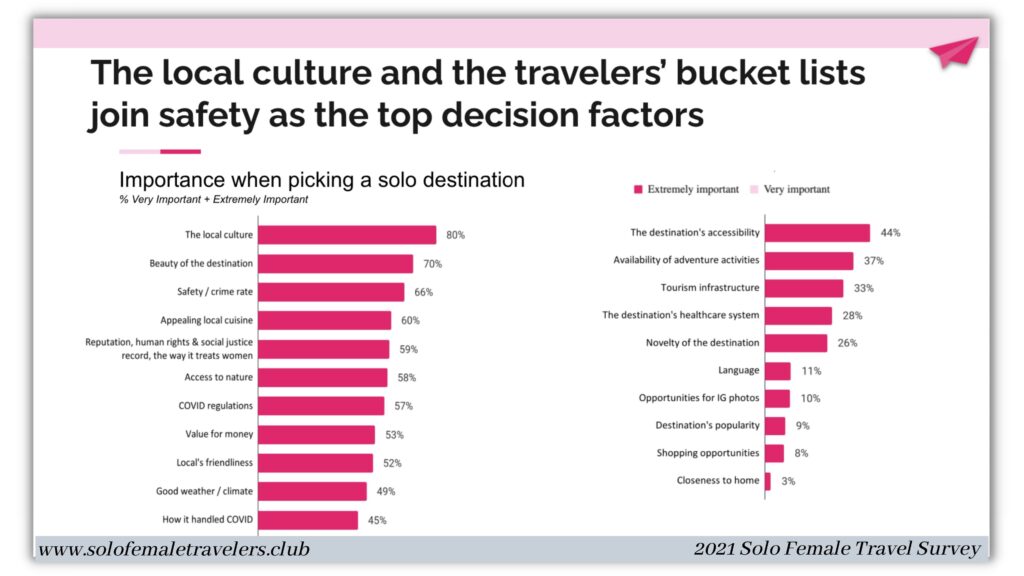
When choosing a destination, solo female travelers look at several decision factors, from culture to nature, beauty, safety, affordability, food, seasonality, accessibility and friendliness of the locals.
Shopping or IG photo opportunities are not relevant to the vast majority of women when deciding where to go.
Judy: “Do away with single-person fee supplements. Make it an incentive for companies who advocate and accommodate solo female travelers”
Findings / Key Insights
- 80% of women traveling solo find the local culture extremely important or very important when deciding on a trip, followed by 70% who look for beautiful destinations.
- Safety at the destination or its crime rate comes up again as an important decision factor when choosing a solo travel destination for 66% of respondents.
- The local cuisine is a decision factor for 60% of respondents.
- 58% of respondents said they care about a country’s reputation, its human and social rights track record and the way it treats women. This shows that solo female travelers are aware of social justice issues and will consider whether a destination aligns with their values when deciding where to go.
- 57% of respondents consider COVID restrictions when picking a destination.
Carolyn: “Make the cost of staying in a female only dorm the same as in a mixed dorm in hostels. Often it is more expensive to stay in the female only room”
10. Solo Female Travelers are interested in cultural activities and immersion, the outdoors, the beach and adventure activities
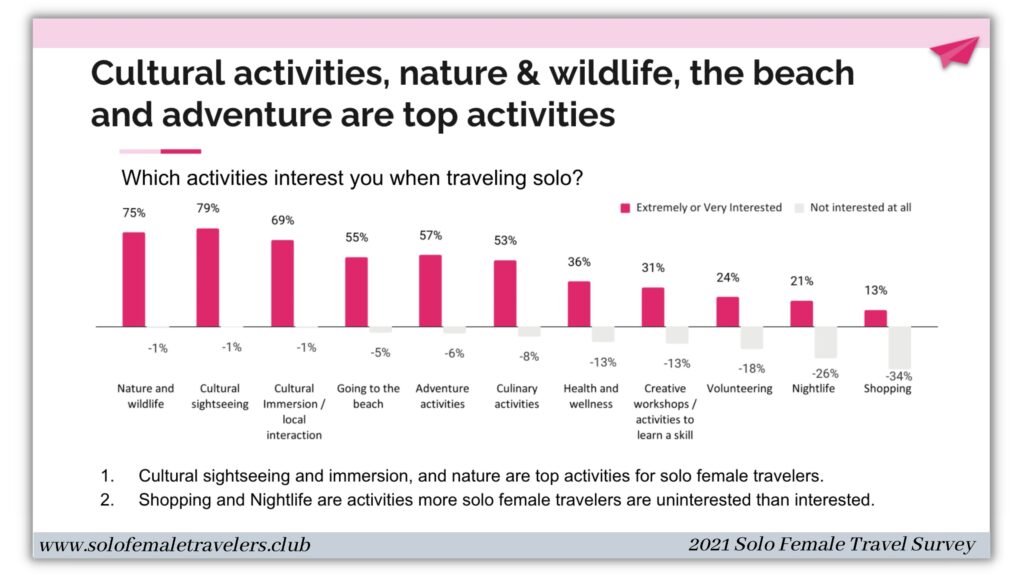
Solo travel for women is a growing trend and with that, the types of women traveling solo have also expanded to include women from all walks of life, all age groups, all backgrounds, all nationalities and all ethnicities.
Stereotypes around wellness and spa days or shopping are no longer representative of the average solo female traveler who is looking for many different things and travels for a variety of reasons.
Responses to our survey also reflect this diversity and, while culture and nature come up on top, there is then a long list of activities women love doing when traveling on their own. This opens up the space to travel and tourism businesses to offer something unique to each of the subgroups and illustrates that fact that there are not only various sub-segments within the solo female travel niche, but there are also many types of trips women who travel solo embark on.
Findings / Key Insights
“I would love to see more female-only tour packages with adventures, food, and exhibits (not only wellness as many women-only things are advertised) especially in countries that feel unsafe for women to travel too.”
- The segment is not homogeneous and there are a wide range of activities women traveling solo are interested in partaking in.
- 70% or more of solo female travelers are interested in cultural sightseeing and activities that involve cultural immersion, followed by nature and wildlife.
- Going to the beach, adventurous or culinary activities are all of interest to at least 50% of the solo female travelers.
- Volunteering or helping out is an emerging interest for women traveling solo. Younger solo female travelers are most keen on traveling with a purpose.
- Age determines interest in activities when traveling; the younger the respondent the higher the interest in nightlife and adventure activities. The older the respondent the higher the interest in creative workshops, and the lower the interest in novel destinations and in shopping.
11. Price drives travel decisions, other decision factors decreased in importance
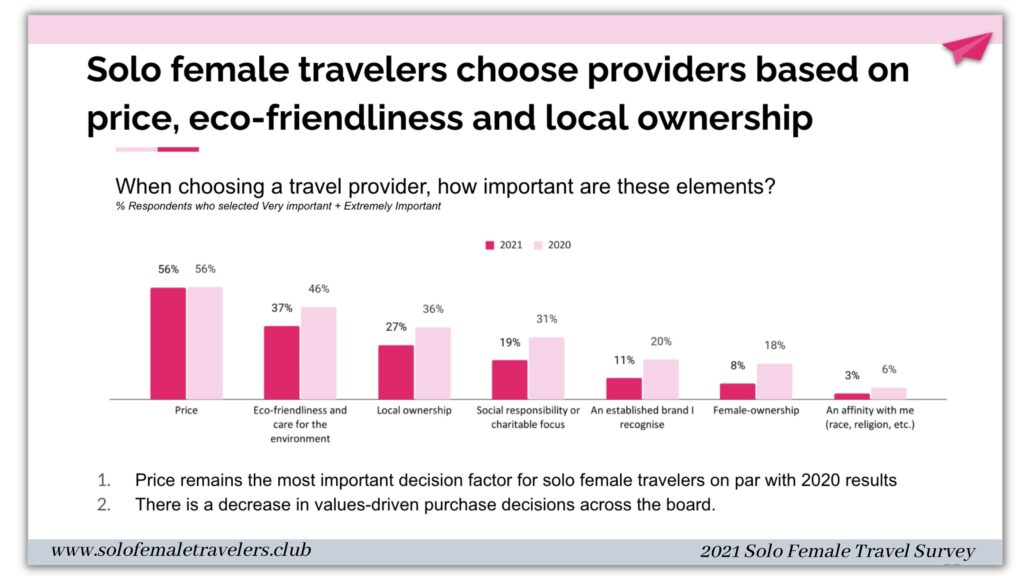
Findings / Key Insights
“I wish the travel industry promoted women owned hostels, hotels, etc.”
- When choosing a travel provider, price is important to 56% of solo female travelers. However, that also means 44% said that price was not that important to their decision.
- Beyond price, women really care about a business’ impact on the environment and its eco-friendliness and 46% said it was important or very important. This is particularly true for Gen X women.
- A business’ ownership is a relevant decision factor for solo female travelers and 37% said they find local ownership important while 18% look for female owned businesses.
- Women also care about about a travel provider’s social impact and whether it participates in projects or contributes to charities that have a positive impact on the society they operate in.
- There are also elements that do not factor into solo female travelers decision and those are whether the brand is recognizable and whether the business has an affinity with them (same religion, same beliefs, same ethnicity).
- We see relevant importance (18%) placed on whether a business is female-owned, and expect this to be a growing trend as more women become aware of the female gap in the travel industry’s senior positions and their ability to have an impact.
12. Improve our safety, reduce single supplements and normalise solo travel
We asked our survey respondents to tell us what they wish the travel industry did to better support them.
28% wants the travel industry to scrap the single supplements, or the higher cost associated with not having someone to share with, 34% wants the travel industry to help them stay safer when traveling solo and 12% asks for solo travel to be normalised.
“Understand that solo travel is increasing and here to stay”
With solo travel on the rise and women at the forefront of this trend, it pays to capture the opportunity early on by focusing on the needs and wants of this segment and their pain points.
Improve safety
The topic of safety is a very complex topic but helping women stay safe when they travel starts with providing accurate data on the risks so they can prepare with tools such as our Solo Female Travel Safety Index or our Safety Tips.
It also requires hospitality staff to be trained to better serve women traveling solo and give them adequate advice and support that is tailored to their needs.
Lastly, it requires institutional support with initiatives such as Costa Rica’s Sofia Network. The travel industry often ignores and hides the real safety concerns of a destination especially for women, putting many in danger; it’s time to be honest and realistic.
“Be more intersectional. Safety information is usually for white able-bodied cis-women. This can be very excluding for many women (WOC/Black women, trans women, women with disabilities etc.).”
Single supplements
A sticking point for any solo traveler is the travel industry’s historical pricing that quotes trips, rooms and cruise ship cabins on a per person sharing basis and charges solo travelers a single supplement.
We price all our group tours on a per person basis and pair travelers so they don’t have to upgrade to a single room if they don’t want to and more travel companies should follow suit.
Other complaints include women-only hostel rooms being priced higher than mixed dorms, and other pricing approaches that penalise solo travelers.
Destigmatise solo travel
Our group members often report hospitality staff commenting on the fact that they are alone with “Is it just you?”, “Don’t you have friends?” or “Where is your husband”, observations that perpetuate the notion that a solo traveler is incomplete and that travel is an activity done in pairs or as a group.
It’s time the travel industry normalises solo travel and provides training to its staff, especially since 76% of travelers have been or are considering going on a solo trip. Solo travel is not niche, it is mainstream, the travel industry marketing materials need to catch up with the reality and start showing realistic solo travelers as much as they show couples and families to encourage more solo travelers and make them feel that they don’t need to wait for a travel partner to set off.
Beyond that, the industry needs to better understand what women traveling solo need, and adapt their offer accordingly, rather than assuming and offering the wrong product. Don’t design a product for solo female travelers based on the advice of women who haven’t traveled solo or on the advice of men.
Who participated in the Solo Female Travel Survey
Respondents were split between women who had traveled solo (approximately 4,000 responses) and those who had not traveled solo yet (approximately 1,000 responses), and each was asked to fill a unique list of questions, with the objective to:
- Provide the travel industry with accurate, updated and detailed solo travel insights, specifically of the needs, preferences, behaviors and challenges of solo female travelers;
- Shed more light into the attitudes of solo female travelers across the world, globally and by region, age group and experience solo traveling, towards marketing efforts, travel providers and destinations.
- Understand the travel preferences of solo female travelers and help the travel industry make data-based decisions on product launches, product details and pricing with solo travel statistics and facts.
Details of the participants in the survey for solo female travelers can be found below.


Purchase the Full Report
For more detailed insights on the findings shared above, including breakdowns by geography, age, and travel experience, as well as actionable recommendations from respondents on how they can be better served, our full reports are available for purchase.
What you’ll find in the report:
- Reasons for traveling solo by Age, Nationality (grouped by continent) and Relationship status
- Worries when traveling solo by level of solo travel experience
- Level of trustworthiness of travel advice by Age, and for those who have not traveled solo yet
- Decision factors when choosing a travel provider by Age and Nationality (grouped by continent)
- Decision factors when choosing a destination by Age
- Activities women like to do when traveling solo by Age and Nationality (grouped by continent)
How We Can Help You: Our Services
Are you looking to better tailor your offer to Solo Female Travelers? Do you want to better understand this segment to adapt your offer? Are you a hospitality leader who wants to train their team to be more aware of the needs and challenges of women who travel solo?
Reach out to us to discuss how we can help you with in-depth data or with our in-depth expertise.
1 Request a bespoke report
Have a query that our published research didn’t cover? Would you like a tailored report looking at a specific solo female traveler segment?
Contact us to request a bespoke report, cutting / segmenting the data in a way that makes a difference to you. Click here to view a list of our variables.
2 Learn how to serve solo female travelers
We provide consultancy services on how your business can better serve / cater to Solo Female Travelers, based on our annual survey insights.
Learn how to adapt and enhance your product to perfectly suit the type of solo female traveler you want to target.
3 Staff training for Female Travelers
We provide corporate and staff training to equip your employees with the knowledge and skills to properly serve Solo Female Travelers.
We offer a range of learning options and can help you adapt your guest welcome processes or your concierge service.
Previous year’s reports
Read the 2020 Solo Female Travel Survey results here.
Copyright Notice & Disclaimer
Solo Female Travel Trends is a publication of Solo Female Travelers. Reproduction of this page / report without express permission is not allowed, except in the case of brief quotation. To quote or reference the survey results, it must be accompanied by a link back to this page as the original source.
This article contains information about Solo Female Travel. The information is not advice, and should not be treated as such. There are no representations or warranties, express or implied, about the completeness, accuracy, reliability, suitability, or availability with respect to the information provided. We do not represent, warrant, undertake or guarantee that the use of guidance in the report will lead to any particular outcome or result. The authors do not assume and hereby disclaims any liability to any party for any loss, damage, or disruption due to use (or misuse) of information, conclusions and insights.


